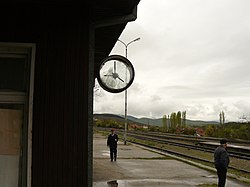|
Zajas
Zajas (Macedonian: ⓘ, Albanian: Zajaz) is a village in the municipality of Kičevo, North Macedonia. Zajas was the seat of the Zajas Municipality, and is now in Kičevo Municipality. HistoryOttomanThe village is attested in the 1467/68 Ottoman tax registry (defter) for the Nahiyah of Kırçova. The village had a total of 73 houses, excluding bachelors (mucerred).[1] Gjorche Petrov (" Materials for the Study of Macedonia ") wrote in 1896 about the population of Zajas: " ... wild, predatory and rude in character, a scourge for the whole of Gorno Kichevo. They spend their time with haidutluk, cattle breeding, agriculture and gurbetlak.“ [2] In statistics gathered by Vasil Kanchov in 1900, the village of Zajas was inhabited by 2150 Muslim Albanians.[3] During the Albanian revolt of 1912, Zajas was the political and organizational center of the insurgent-revolutionary movement for the Kaza of Kičevo. In Zajas, a Committee / Headquarter of the uprising was set up, with the village serving as the meeting place of the Albanian troops, where they received concrete instructions and tasks in order to coordinate their political and revolutionary activity.[4] The village was burned by Chetnik forces and members of the Serbian army during the Balkan wars.[5] YugoslaviaIn September 1913, after the Debar-Ohrid uprising, a group Orthodox Serbs from neighbouring Midinci, under the orders of chetnik Mikajle Brodski, due to their ability to speak the local dialect of Albanian, would dress in Albanian folk dress and parade through Zajas chanting erdhi Shqipëria! (Albania has arrived). This was done with the intent of rounding up the Albanians in one area, which would be the mosque of the Dumaj mahala. The Albanians were instructed to bring one representative from each house in the village. After their arrival, around 300 Albanian men of all ages were executed on the mosque grounds, with around 86 of the bodies being thrown in the nearby well and the rest burned inside a shed. The executions were largely carried out by bayonet, with instances of decapitation also being noted. After the massacre, the remaining Albanians were let go, but would be fired upon after their release, with a number being killed or injured during their flight. A further 56 Albanians had also been massacred near the mill of Veli Xhaka, with their bodies being thrown in the wells of the Xhakallarë mahala. In the immediate aftermath of the massacre, a phenomenon of women stealing and burying the leftover remains of male relatives or family members was noted.[6] On 6 May 1919 the Committee for the National Defence of Kosovo called for a general uprising in Albanian regions in Yugoslavia. Although the uprising was quelled by the Yugoslav army,[7] confrontations continued through the years 1920 and 1921,[8] 1923.[9][10] Macedonian Archival sources show that in the first half of 1920, the activities for organizing an anti-Serb uprising among the Albanian committees were strong, with Kalosh Lazam Dani from Zajas being one of the two the main organizers of revolutionary activity in Vardar Macedonia.[11] The Balli Kombëtar committee held a meeting in Zajas in 1942.[12] Representatives of the Albanian tribes that attended the meeting elected Mefail Shehu as military commander of the region. Shehu's battalion patrolled villages around Zajas. At that period, the Ballist forces successfully repelled the Yugoslav partisans.[12]  In October 1943, a general assembly was called in Zajas, where it was decided that the chairman of the committee of the Balli Kombëtar will be Mefail Shehu, along with Mefail Mehmeti as vice chairman, Begzat Vuli as treasurer and Skender Presevo as under prefect.[12] In the autumn of 1944, the village was captured by communist guerrillas amid a bloody battle.[13] After the battle, the OZNA killed 320 Albanians.[14] DemographicsAs of the 2021 census, Zajas had 2,567 residents with the following ethnic composition:[15]
According to the 2002 census, the village had a total of 4,712 inhabitants.[16] Ethnic groups in the village include:[16]
CultureZajas is notable for a distinct style of rudimentary polyphonic singing.[17] SportsLocal football club KF Zajazi have played in the Macedonian Second League. Notable people
References
External linksWikimedia Commons has media related to Zajas. |
||||||||||||||||||||||||||||

